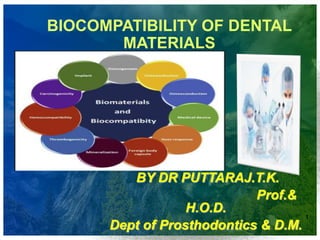biocompatabity.ppt
- 1. BIOCOMPATIBILITY OF DENTAL MATERIALS BY DR PUTTARAJ.T.K. Prof.& H.O.D. Dept of Prosthodontics & D.M. 1
- 2. 10.Keys for successful student life âĒ Analytical skills and communication âĒ Flexibility âĒ Decisiveness âĒ Creativity âĒ Risk taking activity âĒ Stress tolerance âĒ Perseverance âĒ Organizing capabilities âĒ Leadership âĒ Great interest and attitude of openness
- 4. 17-10-2015
- 5. 17-10-2015
- 7. 17-10-2015 Being harmonious with life & not having toxic or injurious effects on biologic function.(G.P.T. 8th edn.-2005)
- 8. 17-10-2015
- 9. 17-10-2015 Any substance, other than a drug, that can be used for any period as a part of a system that treats, augments, or replaces any tissue, organ or function of the body.(G.P.T. 8th edn.-2005)
- 10. 17-10-2015
- 11. 17-10-2015
- 12. 17-10-2015
- 13. 17-10-2015
- 14. 17-10-2015 Regulations & ethics introduced Organisations like FDA,ANSI,ADA and ISO
- 15. 17-10-2015
- 16. 17-10-2015
- 17. 17-10-2015
- 18. 17-10-2015
- 19. 17-10-2015
- 21. 17-10-2015
- 22. 17-10-2015
- 24. 4-04/2021
- 25. 17-10-2015
- 26. 17-10-2015
- 27. 17-10-2015
- 28. 17-10-2015
- 29. 17-10-2015
- 30. 17-10-2015
- 31. 17-10-2015
- 32. 17-10-2015 Tests for Evaluation of Biocompatibility Biocompatibility tests are classified on three levels (tiers) :- Group I : Primary tests Group II : Secondary tests Group III : Usage tests
- 33. 17-10-2015
- 34. 17-10-2015
- 35. 17-10-2015
- 36. 17-10-2015
- 37. 17-10-2015
- 38. 17-10-2015
- 39. 17-10-2015
- 40. 17-10-2015
- 41. 17-10-2015
- 42. 17-10-2015
- 43. 17-10-2015
- 44. 4-4-2021 Australia begins coronavirus vaccine testsâAN EXAMPLE OF CLINICAL TRIAL Australia's national science agency will test two vaccine candidates over the next three months. It is part of a global race to halt the coronavirus pandemic.
- 45. Vaccination drive in India
- 46. 17-10-2015
- 47. 17-10-2015
- 48. 17-10-2015
- 49. 17-10-2015
- 50. 17-10-2015
- 51. 17-10-2015
- 52. 17-10-2015
- 53. 17-10-2015
- 54. TARNISH
- 56. 17-10-2015
- 59. 17-10-2015
- 60. 17-10-2015
- 62. 17-10-2015
- 63. 17-10-2015
- 65. 17-10-2015
- 66. 17-10-2015
- 67. 17-10-2015
- 68. 17-10-2015
- 69. 17-10-2015
- 70. Berylliosis, or chronic beryllium disease (CBD),----- is a chronic allergic-type lung response and chronic lung disease caused by exposure to beryllium and its compounds, a form of beryllium poisoning. 1. Difficulty breathing/shortness of breath 2. Weakness 3. Fatigue 4. Loss of appetite 5. Weight loss 6. Joint pain 7. Cough 8. Fever
- 71. 1. Confirm allergy by Patch test-- Avoid base metal restorations in patients with known allergy 2.Good ventilation & exhaust 3.PROTECTIVES MASKS AND GLOVES SHOULD BE WORN 4.CONSULT THE DOCTOR Berylliosis---Prevention
- 72. 17-10-2015
- 73. 17-10-2015
- 74. 17-10-2015
- 75. 17-10-2015
- 76. 17-10-2015
- 77. 17-10-2015
- 78. 17-10-2015
- 79. 17-10-2015
- 80. 17-10-2015
- 81. 17-10-2015
- 82. 17-10-2015
- 85. 17-10-2015
- 87. 17-10-2015






















































































